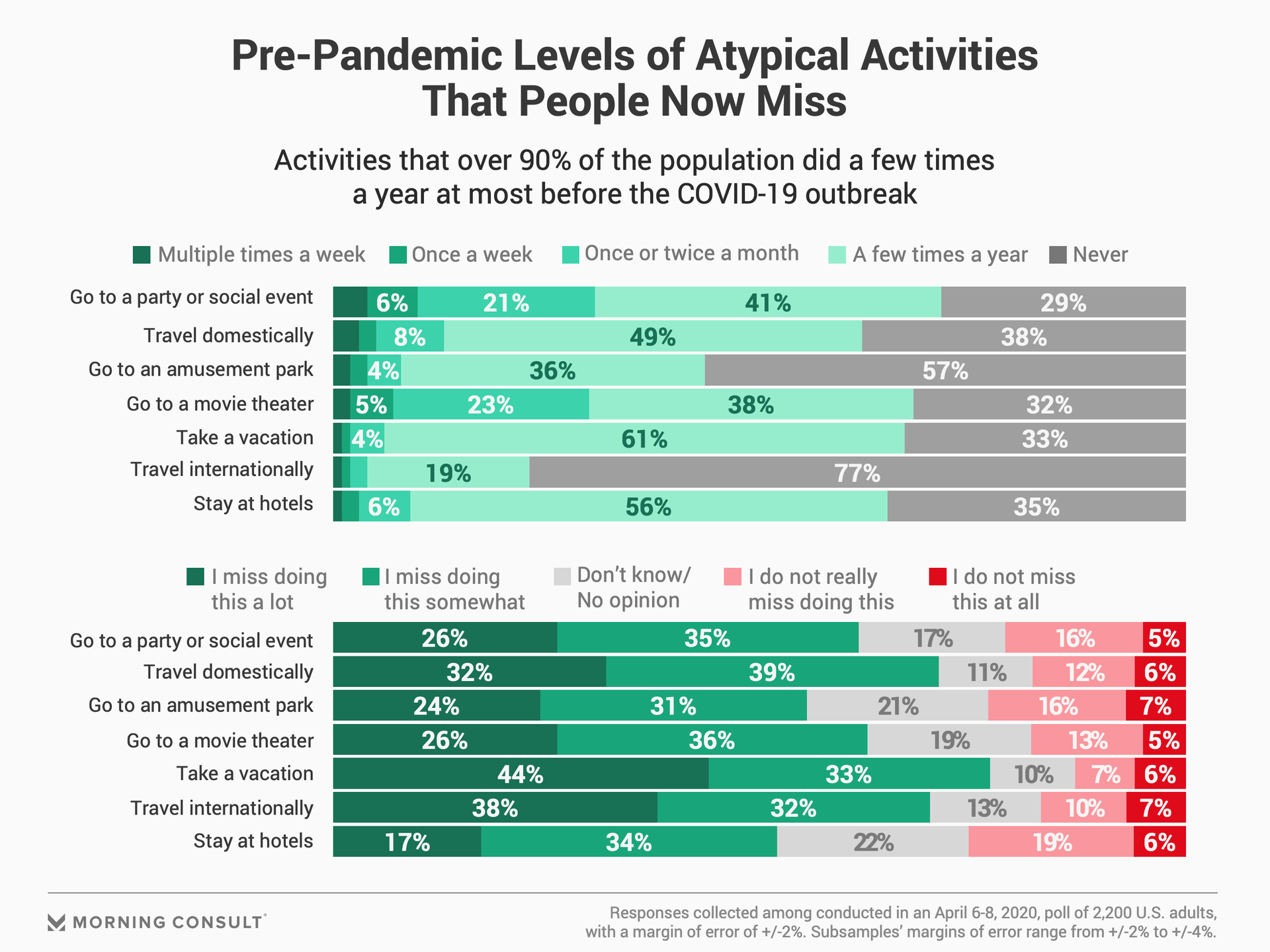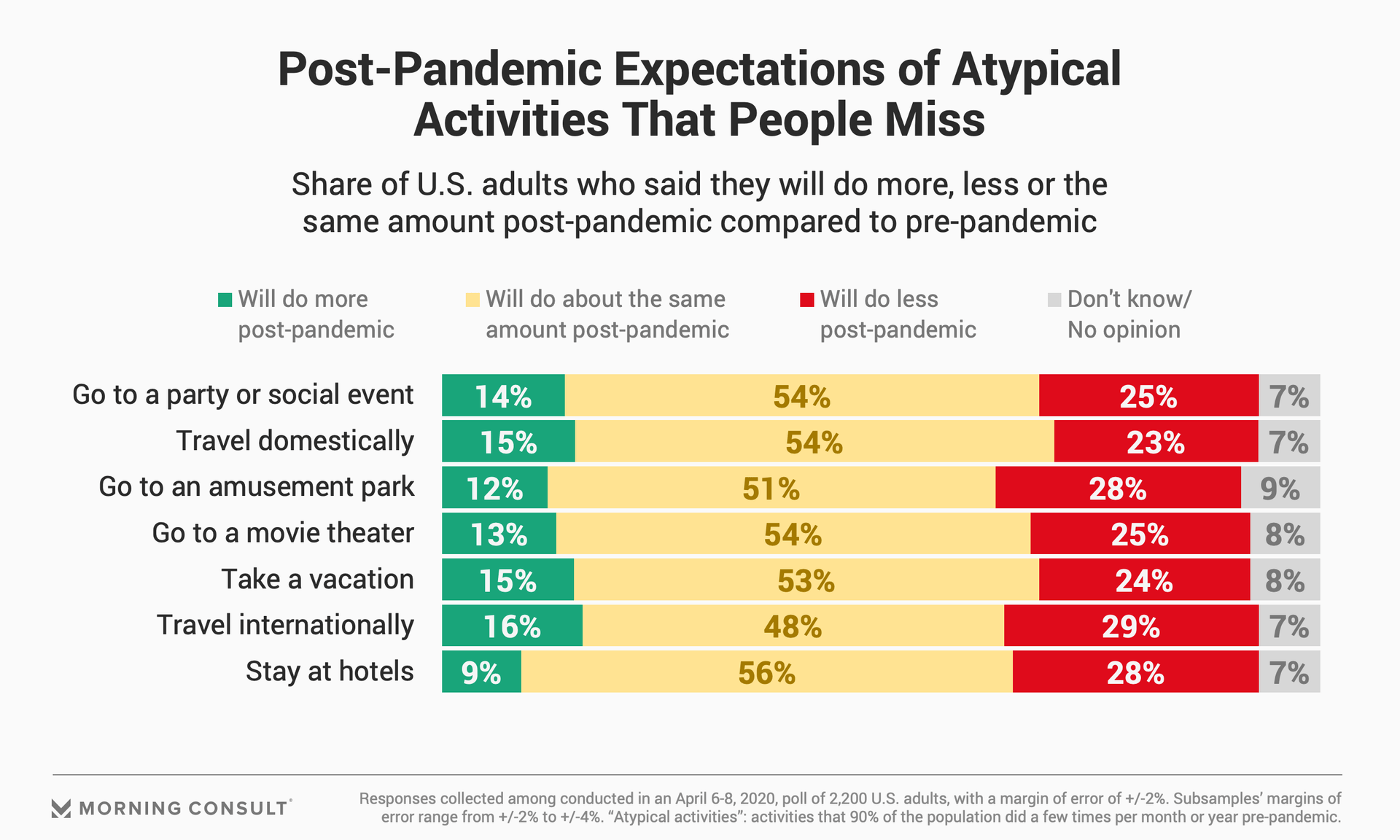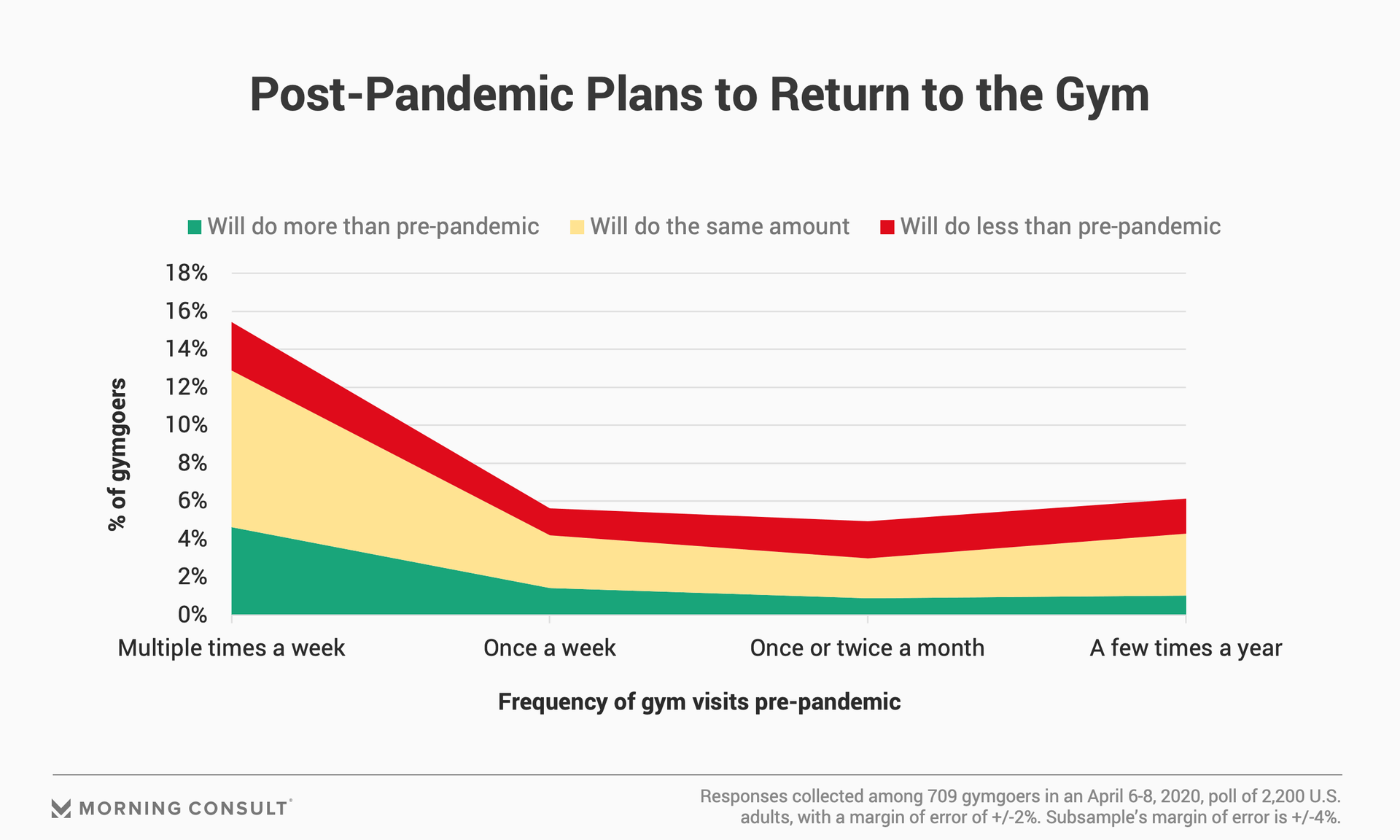Analysis: Anxiously Awaiting or Already Forgotten -- A Look Into Americans' Most-Missed Activities

Key Takeaways
Common pre-pandemic activities separate into four distinct categories, with each sharing commonalities in how much the in-category activities are missed by Americans and the frequency with which adults plan to do these activities post-pandemic.
Expected post-pandemic increases in routine activities suggest that most Americans miss these otherwise-unstrained activities and desire to return to them with greater intensity than before the outbreak.
60% or more adults miss going to a party/social event, traveling domestically, going to an amusement park or a movie theater, taking a vacation and traveling internationally
Morning Consult’s “Favorited or Forgotten” series explores if – and how – consumer behavior will change in a post-COVID-19 world and what business leaders can do to prepare for those changes. Sign up here to receive the latest in your inbox each week.
This analysis was authored by Morning Consult analyst Victoria Sakal.
Americans’ ability to work, go, buy and do has now been stymied for months due to the COVID-19 outbreak in the United States. Work-from-home and shelter-in-place measures, coupled with health-related concerns and economically challenging times, has led consumers to rethink everything from their consumption patterns to their preferred pastimes. As some states begin to reopen, adults are beginning to assess how comfortable they are resuming the activities they did pre-pandemic. But which activities do Americans miss most, and which are they most looking forward to returning to?
Based on how often the average adult tended to do certain activities pre-COVID-19, four categories ranging from consistent necessities to uncommon occurrences emerge: regular routines, periodic pastimes, infrequent indulgences and atypical activities. These four categories of pre-pandemic activity levels share common themes around how much the activities within each category are missed by Americans, and the frequency with which adults plan to do these activities again post-pandemic.

Regular routines
These are activities that the vast majority (65 percent or more) does at least once a week. The more frequently a regular routine activity was done pre-pandemic:
- the less it’s missed now, and the more undecided people are on whether or not they miss the activity, yet
- the more likely it will be done at least the same amount, if not more, post-pandemic.
Staying home, unsurprisingly the most common pre-pandemic activity, is only missed by 17 percent of the population, but the majority of Americans (54 percent) plan to do this as often as they did pre-pandemic. While sentiments toward this activity will continue to be monitored as this crisis continues, the share of consumers missing staying at home likely represents those on the front lines who are working to staff essential businesses and health care centers; those expecting to spend as much time at home as they did before the outbreak are likely retreating to pre-pandemic activity levels, as we see across other regular routine activities.
However, it’s also possible that more than half of adults expecting to stay at home as much post-pandemic reflects hesitance toward or fear of leaving home given the stay-at-home measures and health concerns currently top-of-mind. The near-quarter of the population (23 percent) planning to stay home more after stay-at-home, self-quarantining and social distancing measures end have likely discovered a new appreciation for their home and the activities they can do there.
Similarly, anticipated decreases in the other routine activities may stem from the discovery of favorable alternatives to these activities, individuals’ realization that they don’t want or need to do these activities as much, or, in the case of visiting stores, the intent to make fewer trips and instead buy more each visit, which the current situation is almost certainly conditioning consumers to do. Conversely, post-pandemic increases in routine activities (excluding staying at home) likely reflect that the majority of Americans miss these otherwise-unstrained activities and therefore desire to return to them with greater intensity than before.



Periodic pastimes
This group includes activities that 50 percent to 75 percent of the population does rarely (i.e. a few times a month or less frequently)
The more frequently a periodic pastime activity was done pre-pandemic:
- the more it’s missed now, but
- more frequently done pastimes are generally more likely to be done the same amount, if not less, post-pandemic.
Nearly a fifth of the population is eager to go to parks and public places more than they did pre-pandemic, but a fifth to nearly a quarter of Americans expect to do these pastimes less than they used to. These declines likely reflect a combination of fears of returning to characteristically public spaces following a health crisis, as well as the realizations that there are sufficient alternatives to these activities and possibly even that the expenditure isn’t worth the experience now that they’ve had to live with less of these periodic activities.



Infrequent indulgences
The activities defined as “infrequent indulgences” are those done rarely (i.e. a few times a month or less frequently) by 75 percent to 90 percent of the population. (Going to a shopping mall, which 84 percent of Americans rarely do, is considered an infrequent indulgence as behavior around this activity is more consistent with that of other infrequent indulgences than that of “atypical activities.”)
With carpooling with others being a notable exception (50 percent of those who’ve done this pre-pandemic don’t miss it, and nearly a third of the population expects to do it less post-pandemic), the more often an infrequent indulgence activity was done pre-pandemic
- the more likely adults are to miss it, and
- the more likely they are to do these activities about the same amount if not more post-pandemic.
Conversely, however, the less frequently one of these activities was done pre-pandemic,
- the more likely adults are to not miss it, and
- the more likely they are to do these less than they did pre-pandemic.
While this analysis explored only four infrequent indulgences, these insights have important implications for expected post-pandemic activity levels for other actions generally meeting the same criteria.



Atypical activities
These are activities more than 90 percent of the population does rarely (i.e. a few times a year or less frequently). Within this category, there are three tiers of rarely done activities:
- Activities people really miss: Around 60 percent of Americans miss going to a party/social event, traveling domestically, going to an amusement park or a movie theater, taking a vacation, traveling internationally and staying at hotels
- Activities people have mixed feelings about: About half of Americans who went to sporting events, concerts, theater performances or museums pre-pandemic say they miss these activities
- Activities people really don’t miss: Less than a quarter of adults who’ve used ride hailing services or invested in the stock market miss doing these (the latter is likely because it’s still possible to do so despite coronavirus-related measures enacted).



Of the activities Americans currently really miss, roughly half of Americans expect to resume pre-pandemic activity levels. However, adults are slightly less likely to stay at hotels or go to amusement parks more post-pandemic, and in fact more than a quarter expect to do them less (though potentially related to health and safety concerns more than realizing they can live without these activities). Also, presumably due in part to health-related concerns, nearly a third of Americans expect to travel internationally less post-pandemic.

When it comes to activities like attending sporting events or concerts, those who did these activities more frequently pre-pandemic tend to miss them more, but in general adults are middle of the road in terms of how much they miss these activities, with only about half of Americans missing them. While at least a quarter of Americans anticipate doing these activities less post-pandemic, about half expect to do them about as much as they did before the outbreak.

Among the handful of activities that only about a third of adults do -- using ride-hailing services, which 36 percent of Americans say they’ve done, and investing in the stock market, which 31 percent have done -- but which they definitively don’t miss, adults plan to use ride-hailing services significantly less post-pandemic. They plan to stay about as active in investing as they were pre-pandemic, however.

Of course, while consumers may miss certain activities more than others and plan to do them with different frequency post-pandemic, it’s important to consider these attitudes in the context of when consumers will actually be allowed to do these things again -- and when they’ll be comfortable actually doing them again. The latest Morning Consult research on the topic finds that while most U.S. adults feel it will be a while before they’ll be comfortable returning to everyday life, a growing portion of the population is comfortable returning to certain activities sooner rather than later: Compared sentiments in late-April, twice as many adults are now ready to return to a museum, the gym and even a work conference in the next month.

Diving deeper: fanatic about fitness?
Whether going to the gym or going to workout classes, fitness-related activities are somewhat distinct from the others in that the majority of the population has never done these activities, though a fairly significant share has. Still, the above themes still hold. When considering how much each of these activities is missed and how often adults plan to do each post-pandemic based on how often they did it pre-pandemic, we see that:
- more frequent users miss the activity most (and naturally, rare or non-users miss it least), and
- some frequent users (29 percent and 35 percent of frequent gym-goers and workout class attendees, respectively) will go more often than pre-pandemic, but
- the majority will revert to pre-pandemic levels.
Worth noting is that adults who attended workout classes only a few times a month or less frequently before the pandemic struck are especially susceptible to defecting -- they are nearly as likely to not miss this activity as they are to miss it. Still, given the assessment seen above that Americans expect to be more comfortable returning to gyms or exercise classes before they’re allowed to, it’s clear that this is one area that can expect a post-pandemic resurgence.




Correction: A previous version of this analysis misstated the data from first two "infrequent indulgences" and "atypical activities" charts.
Victoria Sakal previously worked at Morning Consult as a brands analyst.